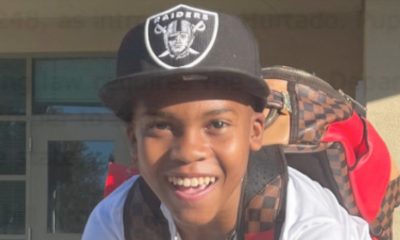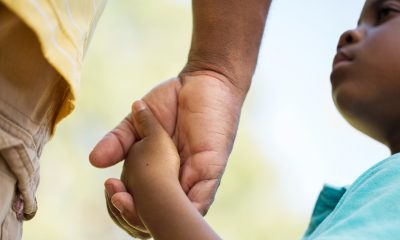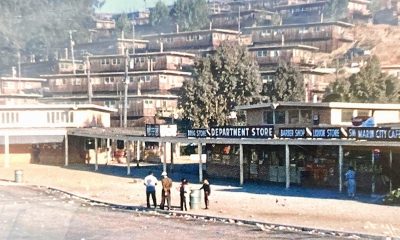Black History
While Some Minority Students and Teachers Thrive in Distant Learning, Others Struggle Daily
NNPA NEWSWIRE — “There’s a bunch of research about the value add of Black teachers in school. It turns out that Black teachers help all students to perform better,” says Sekou Biddle, the Vice President of Advocacy and Student Professional Development Programs at the United Negro College Fund. “White students perform better too. When Black people do well, everyone does well. The problem is that when others do well without us doing well, they leave us behind,” concluded Biddle, who leads advocacy efforts to ensure that more African American students will be college-ready and better prepared to enroll in and complete college.

By Stacy M. Brown, NNPA Newswire Senior National Correspondent
@StacyBrownMedia
Sponsored by the Bill and Melinda Gates Foundation, the NNPA continues its campaign to raise awareness about education barriers for students of color and help bridge the learning gap for minorities, especially during the coronavirus pandemic.
In a series of interviews with Dr. Edwards-Jones and other educators and community stakeholders, the NNPA hopes to push the importance of bridging the education gap and digital divide that has long proven challenging for minority students.
Dr. Peggy Edwards-Jones has spent much of the past two decades as a principal at the Friendship Collegiate Academy Early College Campus in the Northeast section of Washington, D.C.
Incoming freshman at Friendship Collegiate Academy are referred to as scholars.
And with good reason.
In an interview with National Newspaper Publishers Association (NNPA) President and CEO, Dr. Benjamin F. Chavis Jr., Dr. Edwards-Jones relayed what she called her proudest moments in education thus far.
Those moments include graduating over 3,500 scholars, with a 100 percent acceptance rate to a college or university. Some of her scholars graduate with one to two years of college courses completed before leaving high school.
At least 80 percent of those scholars who graduated completed their first year of college. Ninety-nine percent of the students are African American or individuals of color.
“The biggest issue for minority students is an opportunity,” Dr. Edward-Jones offered.
“At our campus, students can select majors like science, engineering, and computer science and take courses toward graduation,” Dr. Edwards-Jones added.
Dr. Edwards-Jones sits on several boards and committees, including the National Save Our Schools Coalition, the American Federation of Teachers Program and Policy Council, D.C. Community School Task Force, and the Advisory Panel to the National Commission on Writing in America’s Schools.
“The overall goal is to make sure that the students are college-ready, so we give them college courses. The biggest thing we have found across the country is access,” Dr. Edwards-Jones posited.
Other professionals noted that access for the underserved is vital.
“We can see our students prevail with access, just like any other groups across the country.”
“Black children need to hear about and learn about Black excellence, not as a set of exceptional stories, but that these are happening every single day,” said Sekou Biddle, the Vice President of Advocacy and Student Professional Development Programs at the United Negro College Fund (UNCF).
“The thing that people miss is the importance of Black educators,” Biddle offered further.
“There’s a bunch of research about the value add of Black teachers in school. It turns out that Black teachers help all students to perform better,” he pronounced.
“White students perform better too. When Black people do well, everyone does well. The problem is that when others do well without us doing well, they leave us behind,” concluded Biddle, who leads advocacy efforts to ensure that more African American students will be college-ready and better prepared to enroll in and complete college.
Biddle manages UNCF’s advocacy platform, including three major components: grass-tops partnerships, grassroots engagement, and messaging and research.
Elizabeth A. Davis, the new president of the Washington Teachers’ Union (WTU), told the NNPA that the pandemic had magnified the digital divide.
“The digital divide is not new, and I am familiar with a lot of the inequities that have existed in D.C. public schools,” Davis noted.
She has helped transform the WTU into a social justice, solution-driven organization dedicated to advancing and promoting quality education for all children regardless of their zip codes or results of a school lottery.
“The pandemic has pulled back the covers on a lot of these inequities, and they’ve been glaring,” Davis added.
“I refer to the achievement gap as the ‘opportunity gap’ because the achievement gap goes to capacity to learn.”
“In our students, I have not met a student in my 40 years of teaching that did not have the capacity to reach whatever bar I set for them. What I have noticed is that the opportunity to learn for African American students, not only in the District but throughout the country, has not been there.”
Davis said the inequities in education must be addressed in meaningful ways.
“We can’t exclude poverty and homelessness,” Davis proclaimed.
“We have 6,000 students in our public school system in D.C. that report to school from homeless shelters. It is going to take a heavy lift and a deep amount of understanding. We cannot overlook the fact that our students, Black and Brown students, have been trying to catch up, and collaboration is key to that. It’s quite critical.”
Finally, Davis offered that teachers also require support.
“In mid-March when teachers had to transition very quickly from brick-and-mortar teaching to distant teaching, they did so in five days with no professional training,” Davis recalled.
“We know we will be in a hybrid model of teaching for some time, so we need to get distance learning right. The first step is closing the digital divide,” she said.
“We want each student to have one-to-one devices, and we need to talk about preparing our teachers with sustained and ongoing professional development that not only help them develop the know-how to use the digital platforms but the know-how to transition to vigorous and well-rounded content.”
Activism
Oakland Post: Week of April 24 – 30, 2024
The printed Weekly Edition of the Oakland Post: Week of April 24 – 30, 2024

To enlarge your view of this issue, use the slider, magnifying glass icon or full page icon in the lower right corner of the browser window. ![]()
Activism
Oakland Post: Week of April 17 – 23, 2024
The printed Weekly Edition of the Oakland Post: Week of April 17 – 23, 2024

To enlarge your view of this issue, use the slider, magnifying glass icon or full page icon in the lower right corner of the browser window. ![]()
Black History
Matthew Henson: Explorer Extraordinaire
Matthew Henson, a trailblazing explorer who overcame countless obstacles to leave an incredible mark on history. Born on August 8, 1866, in Charles County, Maryland, his journey is a testament to the power of determination and the spirit of adventure.

By Tamara Shiloh
Matthew Henson, a trailblazing explorer who overcame countless obstacles to leave an incredible mark on history. Born on August 8, 1866, in Charles County, Maryland, his journey is a testament to the power of determination and the spirit of adventure.
Henson’s life began amidst the backdrop of post-Civil War America, where opportunities for African Americans were scarce. From a young age, he possessed an insatiable curiosity about the world beyond his small town. At the age of 12, he embarked on a journey that would change the course of his life forever when he joined a merchant ship as a cabin boy.
His most famous expedition was his journey to the Arctic with renowned explorer Robert E. Peary. In 1887, Henson joined Peary’s crew as a seaman and quickly proved himself to be invaluable with his skills as a navigator and craftsman. Over the course of several expeditions, Matthew endured extreme cold, treacherous terrain, and grueling conditions as he and Peary sought to reach the elusive North Pole.
In 1908–09, Peary set out on his eighth attempt to reach the North Pole. It was a big expedition, with Peary planning to leave supplies along the way. When he and Henson boarded their ship, the Roosevelt, leaving Greenland on August 18, 1909, they were joined by a large group. This included 22 Inuit men, 17 Inuit women, 10 children, 246 dogs, 70 tons of whale meat, blubber from 50 walruses, hunting gear, and tons of coal.
In February, Henson and Peary left their anchored ship at Ellesmere Island’s Cape Sheridan, along with the Inuit men and 130 dogs. They worked together to set up a trail and supplies along the way to the Pole.
Peary picked Henson and four Inuit people to join him in the final push to the Pole. However, before they reached their destination, Peary couldn’t walk anymore and had to ride in a dog sled. He sent Henson ahead to scout the way. In a later interview with a newspaper, Henson recalled being in the lead and realizing they had gone too far. The group turned back, and Henson noticed his footprints helped guide them to their destination. At that location, Henson planted the American flag.
Henson’s legacy extends far beyond his expeditions to the Arctic. He shattered racial barriers in the world of exploration and inspired countless individuals, regardless of race, to dream big and pursue their passions. In 1937, he was finally recognized for his achievements when he was inducted into The Explorers Club, an organization dedicated to promoting scientific exploration and field research.
Matthew Henson died in the Bronx, New York, on March 9, 1955, at the age of 88.
-

 Activism4 weeks ago
Activism4 weeks agoOakland Post: Week of March 27 – April 2, 2024
-

 #NNPA BlackPress4 weeks ago
#NNPA BlackPress4 weeks agoBeloved Actor and Activist Louis Cameron Gossett Jr. Dies at 87
-

 Community1 week ago
Community1 week agoFinancial Assistance Bill for Descendants of Enslaved Persons to Help Them Purchase, Own, or Maintain a Home
-

 Activism3 weeks ago
Activism3 weeks agoOakland Post: Week of April 3 – 6, 2024
-

 Business1 week ago
Business1 week agoV.P. Kamala Harris: Americans With Criminal Records Will Soon Be Eligible for SBA Loans
-

 Activism2 weeks ago
Activism2 weeks agoOakland Post: Week of April 10 – 16, 2024
-

 Community1 week ago
Community1 week agoAG Bonta Says Oakland School Leaders Should Comply with State Laws to Avoid ‘Disparate Harm’ When Closing or Merging Schools
-

 Community6 days ago
Community6 days agoOakland WNBA Player to be Inducted Into Hall of Fame

























































